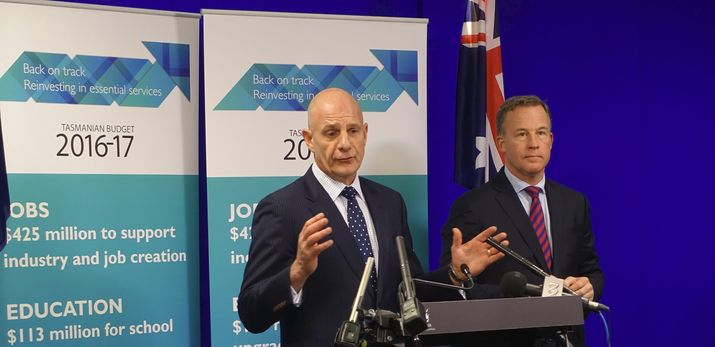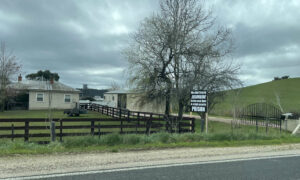*Pic: The buck stops here … Premier Will Hodgman and Treasurer Peter Gutwein spruik the 2016 Budget …
First published November 28
Even Scott Morrison finally got the message. There is good debt, the federal Treasurer pronounced, and there is bad debt. The idea that government debt is not all bad is a turnaround for his side of politics, which rode the debt-and-deficit bandwagon into government in Canberra and in Hobart.
After years of transparent number-fudging in federal budgets, Mr Morrison has come grudgingly to terms with two aspects of fiscal reality: that he will never get to a surplus without increasing taxes rather than cutting them; and that running a government budget is not quite the same as looking after the housekeeping money.
The federal Treasurer, we now know, accepts one of the most basic tenets of public sector finance: borrow to fund productive infrastructure but not to fund recurrent spending.
Borrowing to keep the system ticking over day-to-day runs up so much debt so fast that it becomes unmanageable. You have to have enough money coming in through taxes and other revenue to pay the wages of public servants and to keep the lights on.
Infrastructure – hospitals, schools, roads – is different. But you have to look at the numbers to understand why, and why it’s imperative for the state government to reverse course on debt.
Tasmania’s debt is managed by Tascorp, a branch of Treasury. It operates under a government guarantee, which means it can borrow cheaply. And it does so on behalf of the government itself, the government’s business enterprises, local councils, TasWater and the University of Tasmania.
It raises money mainly by issuing bonds. These are contracts which stipulate that in return for the loan of money over a specified period, the government will pay a certain fixed annual amount in interest. And at the end of the period, it will pay the principal back.
The golden rule of borrowing for infrastructure is that the benefit to the community of an investment in an infrastructure project should be more than the total cost of the borrowing which finances it.”
When companies borrow this way, they can measure that return easily, through increased earnings. A public hospital, a government school or a toll-free road will never make a monetary profit, so the benefit has to be measured differently. That’s called the social return, and for most well-planned infrastructure it is likely to be around 10% to 15% a year.
Let’s take an example. Last year, Tascorp made a bond issue to raise $100 million for 4.35% over 30 years, thereby locking in today’s ultra-low interest rates. Every year from now until 2046, Tascorp will pay $4,350,000 to the owner of that bond and at the end it will pay the whole $100 million back.
On the surface, that doesn’t look like a great deal. After all, in an ordinary mortgage, you don’t have to repay the principal at the end.
But we’re forgetting two important things. One, the eroding effect of inflation on the real value of those repayments over 30 years. Two, the benefit the community gets from the hospital or school which that bond has financed.
The effect of inflation on what we have to pay back is profound. If we assume inflation will run at an average of 2.5% over the next 30 years, the amount we will eventually have to pay back will be not be $100 million but $48 million in 2046 dollars. In real terms, less than half.
And the annual interest payments are similarly affected. After ten years, the real value of $4.35 million will be $3.46 million. In 2036 it will be $2.69 million and by 2046 it will have dropped to $2.09 million.
Taking into account the effect of inflation eroding the real value of what we have to pay back, the total real cost to the state of that $100 million bond over 30 years – principal plus interest – will be $140.58 million.
Let’s say we spend that money on a new hospital building, from which the social value to the community is 10% a year, a fairly conservative assumption. In the first year, that will be the equivalent of $10 million. But over 30 years, that adds up to $300 million.
Taking inflation into account – and it works the other way this time – the real value of that investment to the community will be not $300 million but $614 million.
Either way, the benefit to the community of that hospital building will be several times its cost. In terms of the value of services to the community, we make a profit of $314 million. At the end of all that, we will still have the building.
But the $100 million raised by Tascorp last year is unlikely to be spent on hospitals. It’s far more likely to be for other organisations, particularly TasWater, which is wisely borrowing to fund its huge infrastructure program.
So if the government is not borrowing for its own purposes, what is the result?
Either the hospitals, schools and roads are not built, or they are built with money that would otherwise go to recurrent expenditure – paying doctors, nurses and teachers, buying medicines and so on. In fact, both appear to be happening in Tasmania at the moment.
And this is the biggest single reason why Tasmania has to endure the worst public services, particularly in health and hospitals, in the country. Because of the government’s ideological fixation on reducing debt, the community is missing out on services other Australians are able to take for granted.
As we all know, when our hospitals aren’t up to standard, people endure avoidable pain and suffering.
Some die.
In the past two parliamentary terms, both parties in Tasmania have swallowed the debt-and-deficit Kool-Aid rather than working out the figures. That’s what was behind Lara Giddings’ disastrous budget cuts which brought her government into such poor repute. And it’s behind the present government’s evisceration of hospitals, schools, child protection and a range of other government services.
Perhaps it’s time for a rethink.
*Martyn Goddard is a public policy analyst based in Hobart.
• Rebecca White: Mystery deepens over crucial health report as Ferguson now denies its existence
• Rosalie Woodruff: Tasmania Lagging on Emergency Department Wait Times Under Liberals
• Mercury: Health Minister says report into Tasmanian Health Service does not exist



























john hayward
November 27, 2017 at 10:45
I’m not sure that conservative politicians such as the LibLabs are all that concerned about debt, per se. They have no problem squandering billions on off-shore refugee prisons, submarines and huge concessions to the already rich or themselves.
What they gag at is spending on issues which benefit everyone more or less equally. That’s why they aren’t very hot on public health or education – and why they are attracted to politics.
John Hayward